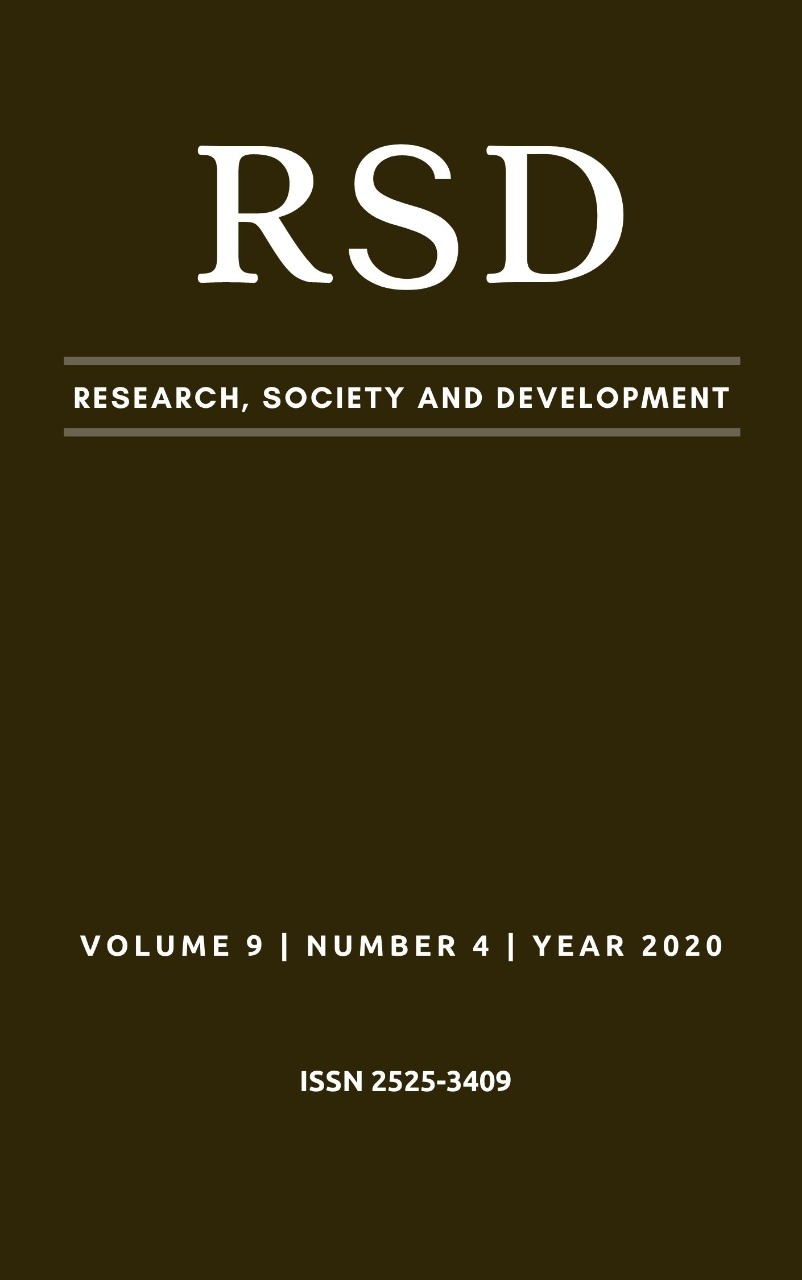Otimização Multi-resposta do processo de estabilização/solidificação de resíduo industrial perigoso
DOI:
https://doi.org/10.33448/rsd-v9i4.2997Palavras-chave:
gestão de resíduos, resíduo perigoso, superfície de respostaResumo
A Solidificação/Estabilização (S/S) é uma técnica importante no tratamento de resíduos perigosos, devido ao seu baixo custo e fácil processamento. O objetivo deste trabalho foi otimizar e padronizar o processo S/S em uma empresa brasileira. Para tal, estudou-se a compactação do resíduo perigoso usando misturas de diferentes materiais como agentes solidificantes: solo argiloso, um polímero superabsorvente (polpa de celulose) e pó de lixa. Foi avaliado o efeito da massa dos solidificantes sobre o volume da mistura compactada, umidade final e o custo do processo de S/S empregando um Planejamento Composto Central. Os resultados mostraram um custo mínimo de R$ 192,89/ton de resíduo líquido, usando cerca de 71,69 (ton de solo argiloso)/(ton resíduo), com uma umidade final menor que 20% (b.u.).
Referências
ABNT- Technical Standards of Brazilian Association, NBR 10.004. Solid waste-classification. 2004 (in Portuguese).
Ahmed, E. M. (2015). Hydrogel: Preparation, characterization, and applications. Journal of Advanced Research, 6(2), 105-121.
Almeida Neto, A.F., Vieira, M.G.A. & Silva M.G.C. (2012). Cu(II) adsorption on modified bentonitic clays: different isotherm behaviors in static and dynamic systems. Materials Research., 15(1), 114-124.
Andrade, M.D., Santos, P.C., Cordeiro, J., Alvarenga, C.A., Santos, C.I.F. & Cordeiro, J.L. (2011). Analysis of destination of industrial solid waste in the state of Minas Gerais between the years of 2011 and 2016. Research, Society and Development, 8(3), e2383855.
Annunciado, T. R. (2005). Estudo da Chorisia speciosa e outras fibras vegetais como sorventes para o setor de petróleo. Universidade Federal do Paraná, Curitiba. Dissertação de Mestrado.
Balcan, M. & Kocasoy, G. (2004). Industrial Sludge Solidification by Using Clinoptilolite. Journal of Environmental Science and Health Part A, 39(4), 951-60.
Barth, E.F. (1990). An overview of the history, present status, and future direction of solidification/stabilization technologies for hazardous waste treatment. Journal of Hazardous Materials, 24(2–3), 103-109.
Borges, T.N., Costa, R.M. & Gontijo, H.M. (2019). Description of a dairy industry effluent: treatment proposal. Research, Society and Development, 8(1), e5081742.
Brito, A. L. F. & Soares, S. R. (2009). Avaliação da integridade e da retenção de metais pesados em materiais estabilizados por solidificação. Eng. Sanit. Ambiental. 14(1), 39-48.
Callé, S, Klaba, L., Thomas D., Perrin, L. & Dufaud, O. (2005). Influence of the size distribution and concentration on wood dust explosion: Experiments and reaction modelling. Powder Technol., 157 (1–3), 144-148.
Cullinare, M. J., Jones, L. W. & Malone, P. G. (1986). Handbook for Stabilization/Solidification of Hazardous Waste. Hazardous Waste Engineering Research Laboratory. Cincinnati, Ohio.
Daian, G. & Ozarska, B. (2009). Wood waste management practices and strategies to increase sustainability standards in the Australian wooden furniture manufacturing sector. J. Cleaner Prod., 17(17), 1594-1602.
Davies, L. C.; Novais, J. M. & Martins‐Dias, S. (2004). Detoxification of olive mill wastewater using superabsorbent polymers. Environ. Biotechnol., 25(1), 89-100.
Evaristo, G.V., Cordeiro, J., Alvarenga, C.A., Oporto, L.T., Quintão, P.L., Calazans,G.M. & Cordeiro, J.L. (2017). Basic sanitation and environmental perception: a study in Candidópolis community in Itabira, Minas Gerais. Research, Society and Development, 4(1), 45-61.
Hubbe, M. A., Ayoub, A., Daystar, J., Venditti, R. & Pawlak, J. (2013). Enhanced Absorbent Products Incorporating Cellulose and Its Derivatives: A Review. BioResources, 8(4), 6556-6629.
Larous, S. & Meniai, A-H. (2012). The Use of Sawdust as by Product Adsorbent of Organic Pollutant from Wastewater: Adsorption of Phenol. Energy Procedia, 18, 905-914.
Melchert, M. B. M., Viana, M. M., Lemos, M. S., Dweck, J. & Büchler, P. M. (2011). Simultaneous solidification of two catalyst wastes and their effect on the early stages of cement hydration. J. Therm. Anal. Calorim., 105(2), 625–633.
Oliveira, D. M. (2003). Aplicação da técnica de solidificação/estabilização para resíduos oleosos da indústria petrolífera, utilizando solo argiloso e bentonita. Universidade Federal de Santa Catarina, Florianópolis. Dissertação de Mestrado.
Santiago, G., Santos, E.A., Cordeiro, J., Santos, C.I.F. & Quintão, P.L. (2019). Panorama of the Municipal Sanitation Plan of Santo Antônio do Rio Abaixo, Minas Gerais. Research, Society and Development, 8(3), e2483846.
Santos, R. V. A. (2015). Polímeros superab,sorventes: processos de produção, aplicações e mercado. Universidade Federal da Bahia, Salvador. Dissertação de Mestrado.
Silva, M.M.N., Carvalho, C.C.A., Lima, D.F. & Alves, L.S.F. (2020). Analysis of solid waste management in the Northeast region of Brazil. Research, Society and Development, 9(1), e130911796.
Tavares, F.B.R., Sousa, F.C.F., Santos, V.E.S. & Silva, E.L. (2019). Analysis of the Access of the Brazilian Population to Basic Sanitation Services. Research, Society and Development, 8(4), e2784867.
Tomasella, R.C., Oliveira. E. G., Angelis, D.F. & Garcia, M. L. (2015). Avaliação do potencial de compostos naturais (argila, turfa e carvão) na remoção de chumbo e toxicidade de um efluente industrial. Eng. Sanit. Ambiental., 20(2), 251-258.
Vidal, A. C. F. & Hora, A. B. (2014). Celulose de fibra longa: uma oportunidade para a indústria brasileira? BNDES Setorial, 39, 281-342.
Vilela, C. N., Braga, Y.O., Silva, V.G.M. & Castro, W.A. (2020). How quality management can contribute to reduce non-conformity in Carmo Do Cajuru movement industries, MG. Research, Society and Development, 9(1), e100911674.
Wiles, C. C. (1987). A review of solidification/stabilization technology. J. Hazard. Mater., 14(1), 5-21.
Downloads
Publicado
Edição
Seção
Licença
Autores que publicam nesta revista concordam com os seguintes termos:
1) Autores mantém os direitos autorais e concedem à revista o direito de primeira publicação, com o trabalho simultaneamente licenciado sob a Licença Creative Commons Attribution que permite o compartilhamento do trabalho com reconhecimento da autoria e publicação inicial nesta revista.
2) Autores têm autorização para assumir contratos adicionais separadamente, para distribuição não-exclusiva da versão do trabalho publicada nesta revista (ex.: publicar em repositório institucional ou como capítulo de livro), com reconhecimento de autoria e publicação inicial nesta revista.
3) Autores têm permissão e são estimulados a publicar e distribuir seu trabalho online (ex.: em repositórios institucionais ou na sua página pessoal) a qualquer ponto antes ou durante o processo editorial, já que isso pode gerar alterações produtivas, bem como aumentar o impacto e a citação do trabalho publicado.


